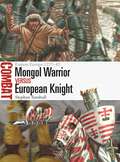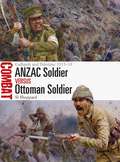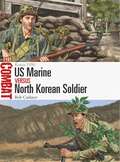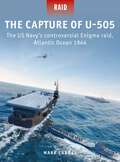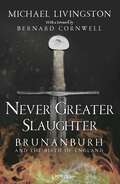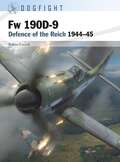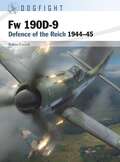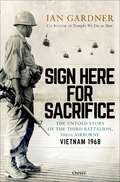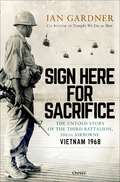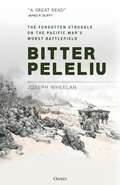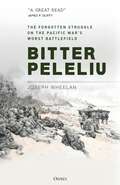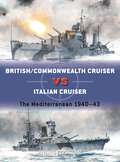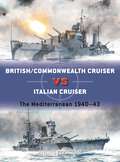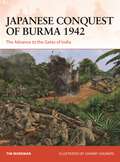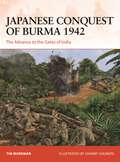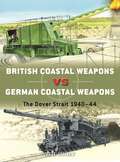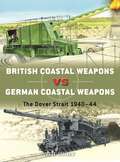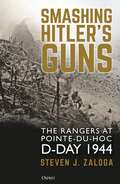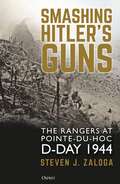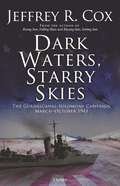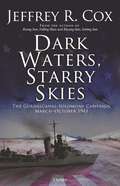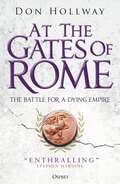- Table View
- List View
Mongol Warrior vs European Knight: Eastern Europe 1237–42 (Combat)
by Stephen TurnbullFeaturing specially commissioned artwork and maps, carefully chosen illustrations and insightful analysis, this book examines the legendary Mongol warriors and their vastly different European opponents. Having conquered much of Central Asia by 1237, the Mongols advanced into the northern Caucasus. The fall of several key centres such as Riazan and Vladimir was followed by Mongol victory at Kiev. Moving west, in 1241 two Mongol armies achieved stunning victories at the battles of Liegnitz in Poland and the Sajo River (Mohi) in Hungary, before suffering their only reverse of the campaign at the fortress of Klis. The Mongol forces regrouped in Hungary to prepare for a further advance into Austria and Germany, but the death of their leader, Ogedei Khan, meant that his generals were required to return to Mongolia to choose a successor. Smaller Mongol forces would return to raid in the years to come, but never again would Western Europe be threatened as it was in 1242.Fully illustrated, this innovative study of the forces that clashed during the Mongol invasion of Europe between 1237 and 1242 allows a comparison to be made between the all-conquering nomad horsemen of the steppes and the mounted knights of the West.
ANZAC Soldier vs Ottoman Soldier: Gallipoli and Palestine 1915–18 (Combat)
by Si SheppardIn 1915–18, ANZAC and Ottoman soldiers clashed on numerous battlefields, from Gallipoli to Jerusalem. This illustrated study investigates the two sides' fighting men.The Gallipoli campaign of 1915–16 pitched the Australian and New Zealand volunteers known as the ANZACs into a series of desperate battles with the Ottoman soldiers defending their homeland. In August 1915, the bitter struggle for the high ground known as Chunuk Bair saw the peak change hands as the Allies sought to overcome the stalemate that set in following the landings in April. The ANZACs also played a key part in the battle of Lone Pine, intended to divert Ottoman attention away from the bid to seize Chunuk Bair. The Gallipoli campaign ended in Allied evacuation in the opening days of 1916. Thereafter, many ANZAC units remained in the Middle East and played a decisive role in the Allies' hard-fought advance through Palestine that finally forced the Turks to the peace table. The fateful battle of Beersheba in October 1917 pitted Australian mounted infantry against Ottoman foot soldiers as the Allies moved on Jerusalem. In this book, noted military historian Si Sheppard examines the fighting men on both sides who fought at Lone Pine, Chunuk Bair and Beersheba. The authoritative text is supported by specially commissioned artwork and mapping plus carefully chosen archive photographs.
ANZAC Soldier vs Ottoman Soldier: Gallipoli and Palestine 1915–18 (Combat)
by Si SheppardIn 1915–18, ANZAC and Ottoman soldiers clashed on numerous battlefields, from Gallipoli to Jerusalem. This illustrated study investigates the two sides' fighting men.The Gallipoli campaign of 1915–16 pitched the Australian and New Zealand volunteers known as the ANZACs into a series of desperate battles with the Ottoman soldiers defending their homeland. In August 1915, the bitter struggle for the high ground known as Chunuk Bair saw the peak change hands as the Allies sought to overcome the stalemate that set in following the landings in April. The ANZACs also played a key part in the battle of Lone Pine, intended to divert Ottoman attention away from the bid to seize Chunuk Bair. The Gallipoli campaign ended in Allied evacuation in the opening days of 1916. Thereafter, many ANZAC units remained in the Middle East and played a decisive role in the Allies' hard-fought advance through Palestine that finally forced the Turks to the peace table. The fateful battle of Beersheba in October 1917 pitted Australian mounted infantry against Ottoman foot soldiers as the Allies moved on Jerusalem. In this book, noted military historian Si Sheppard examines the fighting men on both sides who fought at Lone Pine, Chunuk Bair and Beersheba. The authoritative text is supported by specially commissioned artwork and mapping plus carefully chosen archive photographs.
US Marine vs North Korean Soldier: Korea 1950 (Combat)
by Bob CashnerThis absorbing study casts light on the tactics, weapons and combat effectiveness of the US Marines and North Korean soldiers who fought one another in August and September 1950.Equipped with Soviet tanks and bolstered by a cadre of combat veterans returning from the Chinese Civil War, North Korea's army launched its surprise offensive against the Republic of Korea on 25 June 1950; within days Seoul had fallen and the majority of South Korea's divisions had been shattered. American ground troops rushed to Korea also seemed incapable of stopping the rapidly advancing North Koreans. By August, the remnants of the South Korean and US Army divisions had been pushed into a small corner around the port of Pusan, their backs to the sea. Time was also running out for the North Koreans; virtually all of their planning and preparations were based on a two-month campaign. Although the North Korean People's Army had enjoyed an impressive string of victories, its losses were no longer being replaced in the needed quantity or quality. It was truly a do-or-die moment for both sides.In the wake of World War II, the United States Marine Corps had shrunk from 473,000 men in 1945 to only 70,000 in 1950. Despite its heavily slashed budget and manpower, the Marine Corps responded swiftly and decisively. Active-duty Marines from all over the globe gathered and for once the Marine Corps even received some of the latest American military equipment; it was the Marines' esprit de corps that made the real difference, however. Using first-hand accounts and specially commissioned artwork, this study assesses the KPA and US Marine Corps troops participating in three crucial battles – Hill 342, the Obong-Ni Ridge and the Second Battle of Seoul – to reveal the tactics, weapons and combat effectiveness of both sides' fighting men in Korea in 1950.
The Capture of U-505: The US Navy's controversial Enigma raid, Atlantic Ocean 1944 (Raid)
by Mark LardasU-505 was the first enemy warship the US Navy captured at sea since 1812. This is a new account of how Captain Gallery planned and executed the raid on his own initiative, and how his success almost endangered the war against the U-boats.On June 4, 1944 a US Navy antisubmarine task group in the Atlantic captured an enemy U-boat on the high seas. It was not the first time the Allies had taken a German U-boat as a prize, but the capture of U-505 was different. Captain Gallery and his Task Group 22.3 devised a risky plan to capture scuttled U-boats.This book analyses in detail Gallery's dangerous strategy, using contemporary sources to explore why he thought the reward was worth the risk: instead of attempting to sink the next U-boat that surfaced among them, a destroyer escort would send off its whaleboat. Everyone else was to smother the U-boat with light gunfire to encourage its crew to abandon quickly. Unaware that the Allies had already cracked the German's codes and the capture of a U-boat could endanger that secret, Gallery hoped to capture the vessel's codes and coding equipment to read U-boat message traffic. The plan culminated in the capture of U-505 in early June, which nearly caused the exposure of the Bletchley Park codebreaking secret. Featuring contemporary photographs, specially commissioned artwork and 3D maps, this book is a fascinating exploration of one of the most controversial and dangerous raids, which could have changed the outcome of World War II as we know it.
The Capture of U-505: The US Navy's controversial Enigma raid, Atlantic Ocean 1944 (Raid)
by Mark LardasU-505 was the first enemy warship the US Navy captured at sea since 1812. This is a new account of how Captain Gallery planned and executed the raid on his own initiative, and how his success almost endangered the war against the U-boats.On June 4, 1944 a US Navy antisubmarine task group in the Atlantic captured an enemy U-boat on the high seas. It was not the first time the Allies had taken a German U-boat as a prize, but the capture of U-505 was different. Captain Gallery and his Task Group 22.3 devised a risky plan to capture scuttled U-boats.This book analyses in detail Gallery's dangerous strategy, using contemporary sources to explore why he thought the reward was worth the risk: instead of attempting to sink the next U-boat that surfaced among them, a destroyer escort would send off its whaleboat. Everyone else was to smother the U-boat with light gunfire to encourage its crew to abandon quickly. Unaware that the Allies had already cracked the German's codes and the capture of a U-boat could endanger that secret, Gallery hoped to capture the vessel's codes and coding equipment to read U-boat message traffic. The plan culminated in the capture of U-505 in early June, which nearly caused the exposure of the Bletchley Park codebreaking secret. Featuring contemporary photographs, specially commissioned artwork and 3D maps, this book is a fascinating exploration of one of the most controversial and dangerous raids, which could have changed the outcome of World War II as we know it.
Never Greater Slaughter: Brunanburh and the Birth of England
by Michael LivingstonLate in AD 937, four armies met in a place called Brunanburh. On one side stood the shield-wall of the expanding kingdom of the Anglo-Saxons. On the other side stood a remarkable alliance of rival kings – at least two from across the sea – who'd come together to destroy them once and for all. The stakes were no less than the survival of the dream that would become England. The armies were massive. The violence, when it began, was enough to shock a violent age. Brunanburh may not today have the fame of Hastings, Crécy or Agincourt, but those later battles, fought for England, would not exist were it not for the blood spilled this day. Generations later it was still called, quite simply, the 'great battle'. But for centuries, its location has been lost. Today, an extraordinary effort, uniting enthusiasts, historians, archaeologists, linguists, and other researchers – amateurs and professionals, experienced and inexperienced alike – may well have found the site of the long-lost battle of Brunanburh, over a thousand years after its bloodied fields witnessed history. This groundbreaking new book tells the story of this remarkable discovery and delves into why and how the battle happened. Most importantly, though, it is about the men who fought and died at Brunanburh, and how much this forgotten struggle can tell us about who we are and how we relate to our past.
Never Greater Slaughter: Brunanburh and the Birth of England
by Michael LivingstonLate in AD 937, four armies met in a place called Brunanburh. On one side stood the shield-wall of the expanding kingdom of the Anglo-Saxons. On the other side stood a remarkable alliance of rival kings – at least two from across the sea – who'd come together to destroy them once and for all. The stakes were no less than the survival of the dream that would become England. The armies were massive. The violence, when it began, was enough to shock a violent age. Brunanburh may not today have the fame of Hastings, Crécy or Agincourt, but those later battles, fought for England, would not exist were it not for the blood spilled this day. Generations later it was still called, quite simply, the 'great battle'. But for centuries, its location has been lost. Today, an extraordinary effort, uniting enthusiasts, historians, archaeologists, linguists, and other researchers – amateurs and professionals, experienced and inexperienced alike – may well have found the site of the long-lost battle of Brunanburh, over a thousand years after its bloodied fields witnessed history. This groundbreaking new book tells the story of this remarkable discovery and delves into why and how the battle happened. Most importantly, though, it is about the men who fought and died at Brunanburh, and how much this forgotten struggle can tell us about who we are and how we relate to our past.
Fw 190D-9: Defence of the Reich 1944–45 (Dogfight)
by Robert ForsythThe Fw 190D-9 – the 'long-nosed' Dora – represented the cutting edge and pinnacle of wartime Germany's piston-engine aviation development. This new history by leading German aviation specialist Robert Forsyth reveals what it was like to pilot her in combat as Germany desperately battled to remain in the war.Arguably one of the finest piston-engined fighters ever built, the Focke-Wulf Fw 190D-9 raised the bar in terms of aircraft design and operational capability during World War II. Designed by Kurt Tank, the 'long-nosed' Fw 190D9 'Dora' bettered most of the fighters that the Allied and Soviet air forces could field when it first appeared in the skies over the Western and Eastern Fronts in 1944. Indeed, with experienced German pilots at the controls it proved to be an immediate match for even the later-mark Griffon Spitfire and the P-51D/K. Well-armed, with two 13mm machine guns and two 20mm cannon, the D-9 began to equip Luftwaffe units from August 1944. Later on in the war, one of the key missions of the D-9 was to provide top cover for Me 262 jet fighters when they were at their most vulnerable during take-off and landing. Featuring first-hand accounts, photographs, artwork and innovative and colourful 3D ribbon diagrams, this fascinating volume portrays what it was like to fly the superlative Fw 190D-9 in combat, providing a realistic insight in to how German pilots used the superb Focke-Wulf aircraft in combat against American, British and Russian fighters in the Defence of the Reich in 1944–45.
Fw 190D-9: Defence of the Reich 1944–45 (Dogfight #97)
by Robert ForsythThe Fw 190D-9 – the 'long-nosed' Dora – represented the cutting edge and pinnacle of wartime Germany's piston-engine aviation development. This new history by leading German aviation specialist Robert Forsyth reveals what it was like to pilot her in combat as Germany desperately battled to remain in the war.Arguably one of the finest piston-engined fighters ever built, the Focke-Wulf Fw 190D-9 raised the bar in terms of aircraft design and operational capability during World War II. Designed by Kurt Tank, the 'long-nosed' Fw 190D9 'Dora' bettered most of the fighters that the Allied and Soviet air forces could field when it first appeared in the skies over the Western and Eastern Fronts in 1944. Indeed, with experienced German pilots at the controls it proved to be an immediate match for even the later-mark Griffon Spitfire and the P-51D/K. Well-armed, with two 13mm machine guns and two 20mm cannon, the D-9 began to equip Luftwaffe units from August 1944. Later on in the war, one of the key missions of the D-9 was to provide top cover for Me 262 jet fighters when they were at their most vulnerable during take-off and landing. Featuring first-hand accounts, photographs, artwork and innovative and colourful 3D ribbon diagrams, this fascinating volume portrays what it was like to fly the superlative Fw 190D-9 in combat, providing a realistic insight in to how German pilots used the superb Focke-Wulf aircraft in combat against American, British and Russian fighters in the Defence of the Reich in 1944–45.
Sign Here for Sacrifice: The Untold Story of the Third Battalion, 506th Airborne, Vietnam 1968
by Ian GardnerA hard-hitting history of the U.S. airborne unit who made a name for themselves in the unforgiving jungles of South Vietnam.“It was easier killing than living.” Third Battalion 506th Airborne veteranDrawing on interviews with veterans, many of whom have never gone on the record before, Ian Gardner follows up his epic trilogy about the 506th Parachute Infantry Regiment in World War II with the story of the unit's reactivation at the height of the Vietnam War. This is the dramatic history of a band of brothers who served together in Vietnam and who against the odds lived up to the reputation of their World War II forefathers.Brigadier General Salve Matheson's idea was to create an 800-strong battalion of airborne volunteers in the same legendary “Currahee” spirit that had defined the volunteers of 1942. The man he chose to lead them was John Geraci, who would mold this young brotherhood into a highly cohesive and motivated force. In December 1967, the battalion was sent into the Central Highlands of Lam Dong Province. Geraci and his men began their Search and Destroy patrols, which coincided with the North Vietnamese build-up to the Tet Offensive and was a brutal introduction to the reality of a dirty, bloody war. Gardner reveals how it was here that the tenacious volunteers made their mark, just like their predecessors had done in Normandy, and the battalion was ultimately awarded a Valorous Unit Citation. This book shows how and why this unit was deserving of that award, recounting their daily sanguinary struggle in the face of a hostile environment and a determined enemy.Through countless interviews and rare personal photographs, Sign Here for Sacrifice shows the action, leadership, humor and bravery displayed by these airborne warriors.
Sign Here for Sacrifice: The Untold Story of the Third Battalion, 506th Airborne, Vietnam 1968
by Ian GardnerA hard-hitting history of the U.S. airborne unit who made a name for themselves in the unforgiving jungles of South Vietnam.“It was easier killing than living.” Third Battalion 506th Airborne veteranDrawing on interviews with veterans, many of whom have never gone on the record before, Ian Gardner follows up his epic trilogy about the 506th Parachute Infantry Regiment in World War II with the story of the unit's reactivation at the height of the Vietnam War. This is the dramatic history of a band of brothers who served together in Vietnam and who against the odds lived up to the reputation of their World War II forefathers.Brigadier General Salve Matheson's idea was to create an 800-strong battalion of airborne volunteers in the same legendary “Currahee” spirit that had defined the volunteers of 1942. The man he chose to lead them was John Geraci, who would mold this young brotherhood into a highly cohesive and motivated force. In December 1967, the battalion was sent into the Central Highlands of Lam Dong Province. Geraci and his men began their Search and Destroy patrols, which coincided with the North Vietnamese build-up to the Tet Offensive and was a brutal introduction to the reality of a dirty, bloody war. Gardner reveals how it was here that the tenacious volunteers made their mark, just like their predecessors had done in Normandy, and the battalion was ultimately awarded a Valorous Unit Citation. This book shows how and why this unit was deserving of that award, recounting their daily sanguinary struggle in the face of a hostile environment and a determined enemy.Through countless interviews and rare personal photographs, Sign Here for Sacrifice shows the action, leadership, humor and bravery displayed by these airborne warriors.
Bitter Peleliu: The Forgotten Struggle on the Pacific War's Worst Battlefield
by Joseph WheelanThe hard-hitting history of the Pacific War's 'forgotten battle' of Peleliu – a story of intelligence failings and impossible bravery. In late 1944, as a precursor to the invasion of the Philippines, U.S. military analysts decided to seize the small island of Peleliu to ensure that the Japanese airfield there could not threaten the invasion forces. This important new book explores the dramatic story of this 'forgotten' battle and the campaign's strategic failings. Bitter Peleliu reveals how U.S. intelligence officers failed to detect the complex network of caves, tunnels, and pillboxes hidden inside the island's coral ridges. More importantly, they did not discern – nor could they before it happened – that the defense of Peleliu would represent a tectonic shift in Japanese strategy. No more contested enemy landings at the water's edge, no more wild banzai attacks. Now, invaders would be raked on the beaches by mortar and artillery fire. Then, as the enemy penetrated deeper into the Japanese defensive systems, he would find himself on ground carefully prepared for the purpose of killing as many Americans as possible. For the battle-hardened 1st Marine Division Peleliu was a hornets' nest like no other. Yet thanks to pre-invasion over-confidence on the part of commanders, 30 of the 36 news correspondents accredited for the campaign had left prior to D-Day. Bitter Peleliu reveals the full horror of this 74-day battle, a battle that thanks to the reduced media presence has never garnered the type of attention it deserves. Pacific War historian Joseph Wheelan dissects the American intelligence and strategic failings, analyses the shift in Japanese tactics, and recreates the Marines' horrific experiences on the worst of the Pacific battlegrounds. This book is a brilliant, compelling read on a forgotten battle.
Bitter Peleliu: The Forgotten Struggle on the Pacific War's Worst Battlefield
by Joseph WheelanThe hard-hitting history of the Pacific War's 'forgotten battle' of Peleliu – a story of intelligence failings and impossible bravery. In late 1944, as a precursor to the invasion of the Philippines, U.S. military analysts decided to seize the small island of Peleliu to ensure that the Japanese airfield there could not threaten the invasion forces. This important new book explores the dramatic story of this 'forgotten' battle and the campaign's strategic failings. Bitter Peleliu reveals how U.S. intelligence officers failed to detect the complex network of caves, tunnels, and pillboxes hidden inside the island's coral ridges. More importantly, they did not discern – nor could they before it happened – that the defense of Peleliu would represent a tectonic shift in Japanese strategy. No more contested enemy landings at the water's edge, no more wild banzai attacks. Now, invaders would be raked on the beaches by mortar and artillery fire. Then, as the enemy penetrated deeper into the Japanese defensive systems, he would find himself on ground carefully prepared for the purpose of killing as many Americans as possible. For the battle-hardened 1st Marine Division Peleliu was a hornets' nest like no other. Yet thanks to pre-invasion over-confidence on the part of commanders, 30 of the 36 news correspondents accredited for the campaign had left prior to D-Day. Bitter Peleliu reveals the full horror of this 74-day battle, a battle that thanks to the reduced media presence has never garnered the type of attention it deserves. Pacific War historian Joseph Wheelan dissects the American intelligence and strategic failings, analyses the shift in Japanese tactics, and recreates the Marines' horrific experiences on the worst of the Pacific battlegrounds. This book is a brilliant, compelling read on a forgotten battle.
British/Commonwealth Cruiser vs Italian Cruiser: The Mediterranean 1940–43 (Duel)
by Angus KonstamThis illustrated history explores the cruiser forces of the Italian and British Royal navies, the jack-of-all trades warships of the Mediterranean Naval War.In 1940, when Italy entered World War II, the Royal Navy was badly overstretched, and its Mediterranean Fleet had to face both the Italian Navy and the German and Italian Air Forces in a battle for supremacy. Although the British and Italian battle fleets squared off against each other, they were both often held in reserve, in case the enemy fleet put to sea. So, it was left to the cruisers to wage their own naval war in the Mediterranean. This involved a range of missions, from escorting convoys and hunting enemy ones, to fighting for control of the sea around key locations such as the waters off Malta and Crete. This superbly illustrated study, written by renowned naval expert Angus Konstam, compares and contrasts the design, weapon technologies and combat performance of the opposing cruiser forces. It also documents several major clashes between British, Commonwealth and Italian cruisers, including spirited actions fought off Cape Spada in 1940, a string of actions in the Gulf of Sirte throughout 1941, battles against Axis convoys in 1941–42, and the Battle of Pantelleria in 1942. Among the subjects of the specially commissioned colour artworks are HMAS Sydney, HMS Naiad, RM Trento and RM Raimondo Montecuccoli.
British/Commonwealth Cruiser vs Italian Cruiser: The Mediterranean 1940–43 (Duel)
by Angus KonstamThis illustrated history explores the cruiser forces of the Italian and British Royal navies, the jack-of-all trades warships of the Mediterranean Naval War.In 1940, when Italy entered World War II, the Royal Navy was badly overstretched, and its Mediterranean Fleet had to face both the Italian Navy and the German and Italian Air Forces in a battle for supremacy. Although the British and Italian battle fleets squared off against each other, they were both often held in reserve, in case the enemy fleet put to sea. So, it was left to the cruisers to wage their own naval war in the Mediterranean. This involved a range of missions, from escorting convoys and hunting enemy ones, to fighting for control of the sea around key locations such as the waters off Malta and Crete. This superbly illustrated study, written by renowned naval expert Angus Konstam, compares and contrasts the design, weapon technologies and combat performance of the opposing cruiser forces. It also documents several major clashes between British, Commonwealth and Italian cruisers, including spirited actions fought off Cape Spada in 1940, a string of actions in the Gulf of Sirte throughout 1941, battles against Axis convoys in 1941–42, and the Battle of Pantelleria in 1942. Among the subjects of the specially commissioned colour artworks are HMAS Sydney, HMS Naiad, RM Trento and RM Raimondo Montecuccoli.
Japanese Conquest of Burma 1942: The Advance to the Gates of India (Campaign #384)
by Tim MoremanThis book provides a fascinating exploration of the Japanese conquest of Burma, as the Allied forces were forced back in disarray to India and China.The Japanese invasion of Burma in January 1942 marked the beginning of the single longest campaign of World War II. In the Burmese jungles, the battle-hardened, highly trained and lightly equipped Imperial Japanese Army quickly proved itself a vastly superior fighting force in clashes against the British, Indian and Gurkha troops that formed Burma Army and Chinese nationalist forces deployed in eastern Burma. This superbly illustrated book narrates Burma Corps' epic fighting retreat northwards, carried out mostly in contact with the enemy and across hundreds of miles of highly malarial and extremely difficult terrain, to safety in India. Among the battles covered are the disaster at the Sittang Bridge on 22 February 1942 (where 17th Indian Division was all but destroyed), the fall of Rangoon in March 1942 and the clashes at Yenangyaung, Monywa and Shwegyin. The performance of the opposing commanders and forces is also examined in detail, highlighting the success of Japanese aggressive light infantry tactics, which ruthlessly exploited the cover and concealment provided by the jungle to outflank, bypass and encircle their bewildered enemy.
Japanese Conquest of Burma 1942: The Advance to the Gates of India (Campaign)
by Tim MoremanThis book provides a fascinating exploration of the Japanese conquest of Burma, as the Allied forces were forced back in disarray to India and China.The Japanese invasion of Burma in January 1942 marked the beginning of the single longest campaign of World War II. In the Burmese jungles, the battle-hardened, highly trained and lightly equipped Imperial Japanese Army quickly proved itself a vastly superior fighting force in clashes against the British, Indian and Gurkha troops that formed Burma Army and Chinese nationalist forces deployed in eastern Burma. This superbly illustrated book narrates Burma Corps' epic fighting retreat northwards, carried out mostly in contact with the enemy and across hundreds of miles of highly malarial and extremely difficult terrain, to safety in India. Among the battles covered are the disaster at the Sittang Bridge on 22 February 1942 (where 17th Indian Division was all but destroyed), the fall of Rangoon in March 1942 and the clashes at Yenangyaung, Monywa and Shwegyin. The performance of the opposing commanders and forces is also examined in detail, highlighting the success of Japanese aggressive light infantry tactics, which ruthlessly exploited the cover and concealment provided by the jungle to outflank, bypass and encircle their bewildered enemy.
British Coastal Weapons vs German Coastal Weapons: The Dover Strait 1940–44 (Duel)
by Neil ShortFor the first time ever, compare the British and German World War II big guns duelling with each other and harrying shipping in the Channel.One of the longest-running battles of World War II took place across the English Channel, in which huge artillery guns attempted to destroy each other, created psychological terror among the local inhabitants living near the coast, and harassed shipping over a four-year period.Neil Short examines the array of powerful weapons located across the Strait of Dover. Superb colour artworks explore both fixed gun batteries (including 'Jane' and 'Clem', and batteries Todt and Lindemann) and railway artillery (such as the German K5 and K12 guns, and the British 18in. 'Boche Buster'). Construction and targeting technology used by each side are also covered in detail, and the locations of all the major sites around Dover and Calais are pinpointed on easy to follow maps.
British Coastal Weapons vs German Coastal Weapons: The Dover Strait 1940–44 (Duel)
by Neil ShortFor the first time ever, compare the British and German World War II big guns duelling with each other and harrying shipping in the Channel.One of the longest-running battles of World War II took place across the English Channel, in which huge artillery guns attempted to destroy each other, created psychological terror among the local inhabitants living near the coast, and harassed shipping over a four-year period.Neil Short examines the array of powerful weapons located across the Strait of Dover. Superb colour artworks explore both fixed gun batteries (including 'Jane' and 'Clem', and batteries Todt and Lindemann) and railway artillery (such as the German K5 and K12 guns, and the British 18in. 'Boche Buster'). Construction and targeting technology used by each side are also covered in detail, and the locations of all the major sites around Dover and Calais are pinpointed on easy to follow maps.
Smashing Hitler's Guns: The Rangers at Pointe-du-Hoc, D-Day 1944
by Steven J. ZalogaWritten by one of the world's leading experts on D-Day, Smashing Hitler's Guns is a ground-breaking new history of the legendary Rangers' attack on Pointe-du-Hoc.The Ranger attack on the German gun batteries at Pointe-du-Hoc in the early morning hours of D-Day is the stuff of legend. The gun batteries were strategically positioned between the two American D-Day landing beaches, and were considered the main threat to the Operation Neptune landings. In spite of the confusion and chaos of the June 6, 1944 mission, the Rangers succeeded in scaling the 100-foot cliffs, but the guns were nowhere to be found. Spreading out in all directions, a Ranger team managed to find and spike the guns at their hidden location south of Pointe-du-Hoc. For two days, this small force fought off repeated German attacks, until an American relief force finally arrived on 8 June, by which time more than half the Rangers were casualties. The heroic Ranger mission at Pointe-du-Hoc has indeed become a sacred legend, and as a result there are many unexplored controversies. This new book on this famous raid takes a fresh and comprehensive look at the attack on Pointe-du-Hoc, examining the creation of the German gun battery, the initial Allied intelligence assessments of the threat, and the early plans to assault the site. The forgotten Allied bombing attacks on Pointe-du-Hoc are detailed, as well as the subsequent Allied intelligence investigations of the results. While most accounts of Pointe-du-Hoc are based on the published US Army history, the author has tracked down the long-forgotten original, unedited report in the archives that contains a number of curious changes from the better-known and widely accepted version. Little-known interviews of the Rangers who took part in the mission also shed fresh light and a significant number of German records provide the enemy perspective of the battle for control of the guns.
Smashing Hitler's Guns: The Rangers at Pointe-du-Hoc, D-Day 1944
by Steven J. ZalogaWritten by one of the world's leading experts on D-Day, Smashing Hitler's Guns is a ground-breaking new history of the legendary Rangers' attack on Pointe-du-Hoc.The Ranger attack on the German gun batteries at Pointe-du-Hoc in the early morning hours of D-Day is the stuff of legend. The gun batteries were strategically positioned between the two American D-Day landing beaches, and were considered the main threat to the Operation Neptune landings. In spite of the confusion and chaos of the June 6, 1944 mission, the Rangers succeeded in scaling the 100-foot cliffs, but the guns were nowhere to be found. Spreading out in all directions, a Ranger team managed to find and spike the guns at their hidden location south of Pointe-du-Hoc. For two days, this small force fought off repeated German attacks, until an American relief force finally arrived on 8 June, by which time more than half the Rangers were casualties. The heroic Ranger mission at Pointe-du-Hoc has indeed become a sacred legend, and as a result there are many unexplored controversies. This new book on this famous raid takes a fresh and comprehensive look at the attack on Pointe-du-Hoc, examining the creation of the German gun battery, the initial Allied intelligence assessments of the threat, and the early plans to assault the site. The forgotten Allied bombing attacks on Pointe-du-Hoc are detailed, as well as the subsequent Allied intelligence investigations of the results. While most accounts of Pointe-du-Hoc are based on the published US Army history, the author has tracked down the long-forgotten original, unedited report in the archives that contains a number of curious changes from the better-known and widely accepted version. Little-known interviews of the Rangers who took part in the mission also shed fresh light and a significant number of German records provide the enemy perspective of the battle for control of the guns.
Dark Waters, Starry Skies: The Guadalcanal-Solomons Campaign, March–October 1943
by Jeffrey CoxEsteemed Pacific War historian Jeffrey Cox has produced a fast-paced and absorbing read of the crucial New Georgia phase of the Guadalcanal-Solomons Campaign during the Pacific War.Thousands of miles from friendly ports, the US Navy had finally managed to complete the capture of Guadalcanal from the Japanese in early 1943. Now the Allies sought to keep the offensive momentum won at such a high cost. This is the central plotline running through this page-turning history beginning with the Japanese Operation I-Go and the American ambush of Admiral Yamamoto and continuing on to the Allied invasion of New Georgia, northwest of Guadalcanal in the middle of the Solomon Islands and the location of a major Japanese base. Determined not to repeat their mistakes at Guadalcanal, the Allies nonetheless faltered in their continuing efforts to roll back the Japanese land, air and naval forces. Using first-hand accounts from both sides, this book vividly recreates all the terror and drama of the nighttime naval battles during this phase of the Solomons campaign and the ferocious firestorm many Marines faced as they disembarked from their landing craft. The reader is transported to the bridge to stand alongside Admiral Walden Ainsworth as he sails to stop another Japanese reinforcement convoy for New Georgia, and vividly feels the fear of an 18-year-old Marine as he fights for survival against a weakened but still determined enemy. Dark Waters, Starry Skies is an engrossing history which weaves together strategy and tactics with a blow-by-blow account of every battle at a vital point in the Pacific War that has not been analyzed in this level of detail before.
Dark Waters, Starry Skies: The Guadalcanal-Solomons Campaign, March–October 1943
by Jeffrey CoxEsteemed Pacific War historian Jeffrey Cox has produced a fast-paced and absorbing read of the crucial New Georgia phase of the Guadalcanal-Solomons Campaign during the Pacific War.Thousands of miles from friendly ports, the US Navy had finally managed to complete the capture of Guadalcanal from the Japanese in early 1943. Now the Allies sought to keep the offensive momentum won at such a high cost. This is the central plotline running through this page-turning history beginning with the Japanese Operation I-Go and the American ambush of Admiral Yamamoto and continuing on to the Allied invasion of New Georgia, northwest of Guadalcanal in the middle of the Solomon Islands and the location of a major Japanese base. Determined not to repeat their mistakes at Guadalcanal, the Allies nonetheless faltered in their continuing efforts to roll back the Japanese land, air and naval forces. Using first-hand accounts from both sides, this book vividly recreates all the terror and drama of the nighttime naval battles during this phase of the Solomons campaign and the ferocious firestorm many Marines faced as they disembarked from their landing craft. The reader is transported to the bridge to stand alongside Admiral Walden Ainsworth as he sails to stop another Japanese reinforcement convoy for New Georgia, and vividly feels the fear of an 18-year-old Marine as he fights for survival against a weakened but still determined enemy. Dark Waters, Starry Skies is an engrossing history which weaves together strategy and tactics with a blow-by-blow account of every battle at a vital point in the Pacific War that has not been analyzed in this level of detail before.
At the Gates of Rome: The Fall of the Eternal City, AD 410
by Don HollwayA dramatic retelling of the story of the final years of the Western Roman Empire and the downfall of Rome itself from the perspective of the Roman general Stilicho and Alaric, king of the Visigoths.It took little more than a single generation for the centuries-old Roman Empire to fall. In those critical decades, while Christians and pagans, legions and barbarians, generals and politicians squabbled over dwindling scraps of power, two men – former comrades on the battlefield – rose to prominence on opposite sides of the great game of empire. Roman general Flavius Stilicho, the man behind the Roman throne, dedicated himself to restoring imperial glory, only to find himself struggling for his life against political foes. Alaric, King of the Goths, desired to be a friend of Rome, was betrayed by it, and given no choice but to become its enemy. Battling each other to a standstill, these two warriors ultimately overcame their differences in order to save the empire from enemies on all sides. And when one of them fell, the other took such vengeance as had never been seen in history. Don Hollway, author of The Last Viking, combines ancient chroniclers' accounts of Stilicho and Alaric into an unforgettable history of betrayal, politics, intrigue and war for the heart and soul of the Roman Empire.
